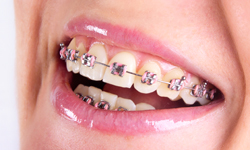
For Kids and Teens
Early Orthodontic Treatment for Children (Also called “Phase I Treatment”)
What is the difference between early orthodontic treatment and regular orthodontic treatment, and why might my child need early treatment? How will early treatment benefit my child in the long run?
Along with the American Association of Orthodontists, we recommend that a child receive his or her first orthodontic screening by the age of seven. By starting treatment early, we are able to recognize potential problems early and correct them before they become more serious. This not only saves you and your child time, but also money.
Early orthodontic treatment has proven to be beneficial for the overall desired result. Because a young child’s permanent teeth have not finished erupting, we are able to evaluate the front-to-back and side-to-side tooth relationships thoroughly and address any impending orthopedic problems at its earliest stage.
During your child’s initial evaluation, we will first determine if there are any problems that need to be addressed, such as crowding, crossbites, submerged teeth, open bite, or overbite. If Drs. Ahl or O’Connor feel early treatment is indicated, they will create a personalized treatment plan for your child that should be the most beneficial for his or her specific case.
Early orthodontic treatment varies between patients but may include removable or fixed appliances that can: provide more room for crowded, erupting teeth; preserve space for unerupted teeth; create facial symmetry through manipulating jaw growth; reduce the possibility of tooth extraction; and reduce overall treatment time in braces once all of the permanent teeth erupt.
How to tell if your child may need early orthodontic treatment:
- Early or late loss of baby teeth (your child should typically start losing teeth around age five, and will have all permanent teeth around age 13)
- Difficulty chewing and/or biting
- Your child continues sucking his or her thumb after age five
- Speech impediments
- Protruding teeth (the top teeth and the bottom teeth extend away from each other)
- Teeth that don’t come together in a normal manner or even at all
- Shifting of the jaw when your child opens or closes his or her mouth (crossbites)
- Crowded front teeth around age seven or eight
- Mouth breathing
If your little one shows signs of needing orthodontic care, or you have been directed by your family dentist to visit an orthodontist, please contact our practice and schedule an appointment. Our team will provide your child with an initial exam and discuss with you the best steps to take toward caring for your son or daughter’s smile.
Full Orthodontic Treatment

Traditional Metal Braces
Traditional metal braces are the most common type of braces and are more comfortable today than ever. Made of high-grade stainless steel, metal braces straighten your teeth using metal brackets and archwires. With metal braces, you have the option of adding colored elastics for a more unique and colorful smile. These colored elastics are changed at each appointment, which is typically every six to eight weeks.

Clear (Ceramic) Braces
Clear braces are a cosmetic option for people who don’t want the look of metal braces. They work exactly the same as traditional metal braces. Clear braces are placed only on the top teeth. When you bite down, your top teeth bite on your lower teeth.
Metal braces are more durable so they are able to withstand strong biting forces better. Your treatment time will be exactly the same with metal or clear braces.

Clear Aligners
Clear aligners are a series of invisible, removable, and comfortable acrylic trays that straighten your teeth like braces. Not only are the aligners invisible, they are removable, so you can eat and drink what you want while in treatment; plus, brushing and flossing are less of a hassle. The aligners are comfortable and contain no metal to cause mouth abrasions during treatment.


 Website Powered by Sesame 24-7™
Website Powered by Sesame 24-7™